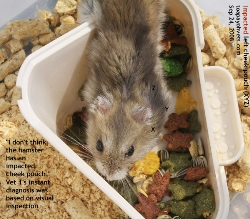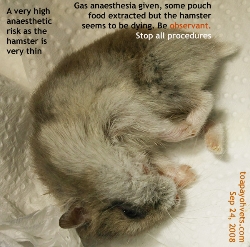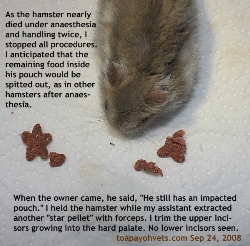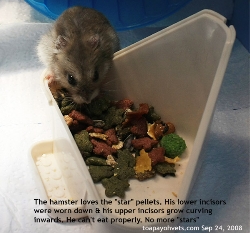An impacted cheek pouch
"Seldom do I see a man keeping hamsters," I was surprised to see a man
in his thirties
dressed in office clothes consulting me about a dwarf hamster. The man
said, "6 years ago, I rescued hamsters abandoned in a box and I have been
keeping hamsters since. My wife also love hamsters."
This one-year-old male dwarf hamster was thin, slightly dehydrated but
extremely active.
"He just does not eat much," the young man lamented. "He had difficulty eating and
had lost so much weight. I am worried that he may die from hunger. I
think he has an impacted cheek pouch." Young people nowadays
do internet research and his diagnosis which was spot-on.
Yet if you were to look at the front of the hamster's face, the hamster's
cheeks were normally sunken when viewed frontally. Therefore Vet
1 diagnosed that the cheek pouch was not impacted based on
visual inspection. That would be an incorrect diagnosis. The best way to
diagnose this case is to hold the hamster and feel the hard lumpy mass in
his left cheek pouch. There was the reddish skin near the left cheek but
further back and upwards. This hair loss was due to the continual rubbing
by the hamster as the pouch gets inflamed due to obstruction of lots of
food.
The hamster had stuffed his left cheek pouch full of dry feed far back
behind his ears. The swelling of the back cheek pouch was full of
crumbly food and felt like hard lumps. This swelling stretched the skin
from the top and above the hamster's left eye.
There was one clue. A patch of hair loss of around 0.5 x 0.5 cm on the
left cheek as the hamster had tried to remove the impacted food
unsuccessfully.
 |
| So thin
despite an abundance of food and lots of tender loving care from a
young couple. Something is not right in this hamster. The couple
diagnosed impacted left cheek pouch |
Veterinary anaesthesia
The vet should not try to restrain the hamster and pull out the impacted
food in this case. The pouch was too full. It would take a long time to
grip the hamster. As the hamster struggles, his heart may stop beating as
he would likely die from the stress of handling and forcing open his mouth
for over a minute.
Anaesthesia as an alternative was high risk as this hamster was not in good health. He was not
eating for many days and was slightly dehydrated. If I did not clear his
impaction, he would die from hunger as he ate less every day. This was high risk
anaesthesia. There was no choice.
I put the hamster inside a plastic container and gave the hamster around 30 seconds of the isoflurane gas
via the endotracheal tube.
He was sleepy,
in the twilight zone but not fully in surgical anaesthesia after 30
seconds. My assistant quickly took him out and put him on the operating
table.
I inserted forceps into his left cheek pouch and pulled out his food. Pink crumbs came out. Then an intact "star-shaped
dry food made in Japan was pulled out. This was surprising as hamsters
normally break down the dry food before storing it. Why and how could
he swallow intact "stars" which should have been chewed upon?
 |
| Isoflurane
gas anaesthesia knocked out this hamster to enable removal of the
food obstructing his left cheek pouch |
The hamster's eyes popped out as he woke up and struggled to get free.
"Stop holding him!" I said to my assistant. "He looks as if he is going to
die from heart failure."
The hamster went limp. Was he going to die or was he dead?
We let the hamster rest for two minutes. Then he
was given the gas anaesthesia and more crumbs were pulled out. The hamster
was exhausted and seemed to be going to die again.
"Stop all
work," I instructed my assistant. "Let the hamster recover in the
hamster's cage." We left him alone for over an hour.
In many healthy hamsters, the remaining
seeds or pellet inside the pouch would be disgorged. So I presumed that
this hamster would do so. I did not handle him the 3rd time to clear the
remaining food. In case he
died from the stress of restraint and strange smells in the veterinary
surgery on the 3rd handling. Better safe than sorry.
 |
| Another
intact "star" pellet remained in his pouch. The evidence was staring
in my face but I did not see it on the towel papers where I had
placed the extracted food in the cheek pouch. This hamster eats or
hoards mostly "star" pellets and no seeds. |
When the owner came to get the hamster home
at 5 pm, he said, "There is still some
impaction in his left cheek." He was correct. This hamster did not
dislodge the remaining crumbs as I anticipated what other hamsters had
done after general anaesthesia. They would rub their cheek pouches and
spit out the stored seeds and crumbs.
Now the observant owner pointed out to a small swelling far back in the
left cheek pouch.
This time there was no need for anaesthesia as the amount was small. My
assistant used the forceps to pull out the food while I restrained
the hamster using my right thumb and forefinger.
Mr Saw had been bitten a few times by hamsters and he always put on cotton
glove in his left hand to restrain the hamster. This was not practical as
the glove removed all feelings of restraining the dwarf hamster was so
small. Therefore I held the hamster's scruff of the neck while he picked
out another "star" and a piece of crumb. His forceps gripped and pulled
out a thin sac of around 1 cm in length.
Veterinary Anatomy
of the cheek pouch is important.
This is where a knowledge of anatomy is so important. It was the lining of
the everted
cheek pouch. Reddish brown and inflamed. If there is no knowledge of
veterinary anatomy of the cheek pouch,
the pouch might be mistaken for some obstructed food remains and pulled
out or cut away.
I took the forceps from Mr Saw, held the hamster by the scruff of his neck
and push back the pouch into his mouth. This hamster did not bite at
all but Mr Saw had been bitten by a hamster previously. So he was extra
cautious. Once bitten, twice shy?
This time the pouch was fully emptied. The hamster started to eat the
"star" too. He had this obsessive compulsive behaviour of eating
"stars" only.
I advised the owner that this hamster cannot be given "star"
crumbs anymore since he had no good front teeth to break the pellets to
pieces.
Normally a hamster has two upper and two lower front
teeth. In this hamster, the lower front teeth had disappeared. His upper
front teeth had curled inwards instead of growing straight downwards. This
could be due to his eating of the "star" pellets.
I took a cutter and snipped a bit off the curly upper front teeth so that
the teeth would grow downwards. The lower front teeth should grow again
now that no "star" pellets are feed. This would take some weeks. Then he would eat properly.
In this case, more than an impacted cheek pouch was involved. The
hamster's lower front teeth had been worn down and his upper front teeth
had grown curling inwards. I deduce that this was due to the hamster's
obsession with eating mainly "star" pellets. The harder pellets could have
worn down his lower front teeth and forced his upper front teeth to grow
inwards and upwards in time.
 |
| The owner
feeds mainly dry pelleted food and few seeds, wearing down the
hamster's lower front teeth to the gum. The upper front teeth grows
but curls inwards and towards the hard palate. It was extremely
difficult for the hamster to eat food now. But it was easy for him
to store the intact "stars" in his left cheek pouch. He was dying
from hunger in the presence of an abundance of food!
|
This hamster would die of hunger soon as it
could not eat properly. He was still active.
With the young couple's nursing and hand feeding
of soft seeds, this hamster should recover. The lower front teeth should
grow normally and this dwarf hamster should live to old age. Being bitten
by hamsters during handling is part of the risks of vets. In this case, my
assistant needed worry in the first place. The dwarf hamster was not
capable of biting him.
But once bitten, twice shy. My assistant wears double cotton hand gloves
in handling the hamster for me as one glove was ineffective. As for me, I
hold the hamster by the scruff of the neck so that he cannot bite my hand
as it is so difficult to manage a hamster wearing thick gloves for
protection!
 TOA
PAYOH VETS
TOA
PAYOH VETS TOA
PAYOH VETS
TOA
PAYOH VETS